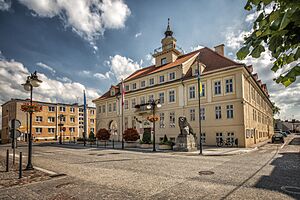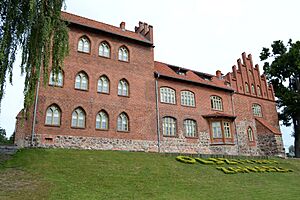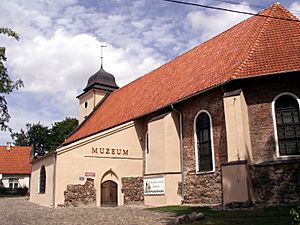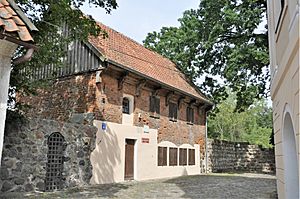Olsztynek facts for kids
Quick facts for kids
Olsztynek
|
|||
|---|---|---|---|

Market Square and town hall
|
|||
|
|||
| Country | |||
| Voivodeship | |||
| County | Olsztyn | ||
| Gmina | Olsztynek | ||
| Town rights | 1359 | ||
| Area | |||
| • Total | 7.69 km2 (2.97 sq mi) | ||
| Population
(2017)
|
|||
| • Total | 7,677 | ||
| • Density | 998.3/km2 (2,585.6/sq mi) | ||
| Time zone | UTC+1 (CET) | ||
| • Summer (DST) | UTC+2 (CEST) | ||
| Postal code |
11-015
|
||
| Vehicle registration | NOL | ||
| Highways | |||
| National roads | |||
| Website | http://www.olsztynek.pl | ||
Olsztynek [ɔlʂˈtɨnɛk] is a charming town located in northern Poland. You can find it in the Warmian-Masurian Voivodeship, which is a region known for its beautiful lakes and forests. It's the main town of the Gmina Olsztynek area and is part of the historic region called Masuria. The town has a rich history, especially linked to the Teutonic Knights and important battles.
Contents
Exploring Olsztynek's Location
Olsztynek is about 28 km (17 mi) south of a bigger city called Olsztyn. It sits in the western part of the Masurian Lake District, which is famous for its many lakes. The town is also near the Baltic Uplands, a hilly area.
Getting Around Olsztynek
Olsztynek is well-connected, making it easy to visit.
Roads and Highways
- The S7 expressway passes near Olsztynek. This major road connects cities like Gdańsk, Warsaw, and Kraków.
- Another important road, the S51 expressway, directly links Olsztynek to Olsztyn.
- The National road 58 also runs through the town, adding to its good transport links.
Train Travel
- Olsztynek has a train station. It's a stop on the railway line that goes from Olsztyn to Działdowo.
A Look at Olsztynek's Past
Olsztynek has a long and interesting history, dating back many centuries.
Early Beginnings of the Town
- Around 1351, the Teutonic Knights built a castle here. This was done to help settle the lands of the Old Prussians.
- The town received its official town rights in 1359 from Grand Master Winrich von Kniprode. This meant it could grow and govern itself.
- Olsztynek then became an important center for local administration within the State of the Teutonic Order.
Battles and Changes
- A very famous battle, the Battle of Grunwald, happened near Olsztynek in 1410. In this battle, Polish and Lithuanian forces defeated the Teutonic Knights.
- After this battle, Olsztynek was burned down to prevent it from falling into Polish hands. However, it was quickly rebuilt.
- The town faced high taxes from the Knights, which led it to join the Prussian Confederation in 1444. This group was against the Knights' rule.
- In 1454, the town wanted to be part of the Kingdom of Poland. But it returned to the Knights' control during the Thirteen Years' War (1454–66).
- After a peace treaty in 1466, Olsztynek became a fief of Poland, meaning it was still connected to Poland but ruled by the Knights.
- In 1525, the town became part of the Duchy of Prussia, which was also a Polish fief.
- During the Polish–Teutonic War (1519–21), Polish troops captured the town.
Later Centuries
- In 1656, during a war with Sweden, Swedish troops plundered Olsztynek.
- In 1701, Olsztynek became part of the Kingdom of Prussia.
- A big fire in 1804 destroyed many houses and the town hall.
- During the Napoleonic Wars in 1807, French soldiers, including famous generals, stayed in Olsztynek.
- After 1871, the town became part of the German Empire.
- Even though it was under German rule, many Polish people lived in Olsztynek in the late 1800s.
Olsztynek in the 20th Century

Gothic Revival Sacred Heart church
- In August 1914, at the start of World War I, a major battle called the Battle of Tannenberg took place near Olsztynek. German forces defeated Russian troops.
- The town was badly damaged during this battle, with many buildings destroyed.
- Olsztynek was rebuilt after the war, with help from the city of Leipzig.
- In 1920, people in the region voted to decide if they wanted to stay with Germany or join the newly independent Second Polish Republic. Most people voted to remain with Germany.
- A large Tannenberg Memorial was built near Olsztynek in 1927 to remember the 1914 battle.
- During World War II, parts of this memorial were used as a prisoner-of-war camp.
- In 1945, the Soviet army occupied Olsztynek. Later, it became part of Poland.
- Many German residents moved away, and Polish people, especially those from areas that became part of the Soviet Union, settled in Olsztynek.
- In 1960, a new memorial was built by Polish authorities to honor the 1410 Battle of Grunwald.
Sports and Recreation
- The local football (soccer) team in Olsztynek is called Olimpia Olsztynek. They play in the lower leagues.
Famous People from Olsztynek
- Krzysztof Celestyn Mrongovius (1764–1855): A Polish pastor, linguist, and writer who worked to preserve the Polish language. His birthplace is now a museum.
- Hieronim Derdowski (1852–1902): A Kashubian-Polish intellectual, poet, and activist.
- Paul Kahle (1875–1964): A German expert in Middle Eastern languages.
- Albert Lieven (1906–1971): A German actor.
Images for kids

All content from Kiddle encyclopedia articles (including the article images and facts) can be freely used under Attribution-ShareAlike license, unless stated otherwise. Cite this article:
Olsztynek Facts for Kids. Kiddle Encyclopedia.






